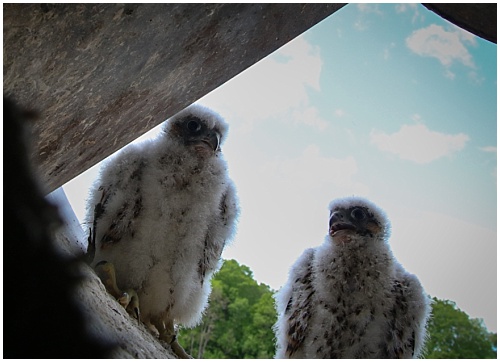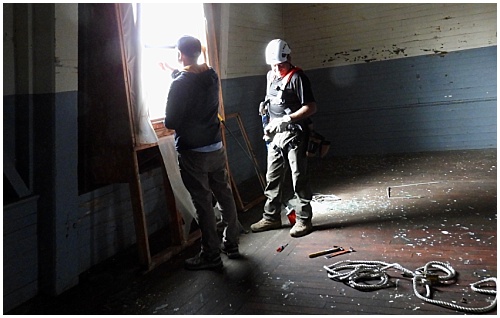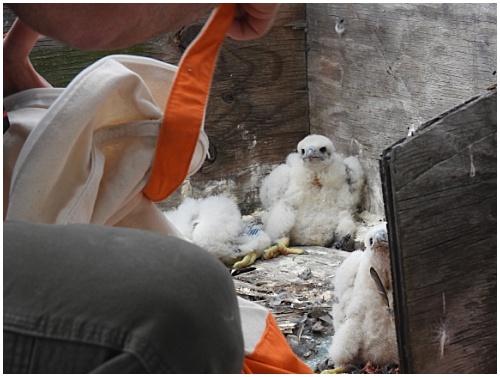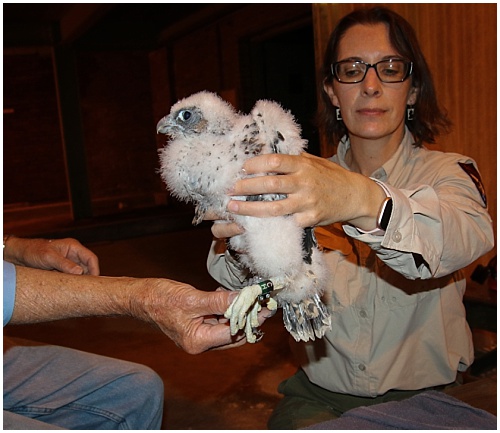July 13, 2021 at 1:03 pm

The keen eyes of one of the many MDIFW peregrine falcon surveyors, Trish Berube, and the partnership of Chinburg Properties, led to the discovery of a female incubating eggs in a 14-year-old nest box on a historical building in Lewiston. The exact location of this nest box is being kept private at this time to limit disturbance to the young until they fledge early summer. The box was only once documented being used by peregrine many years ago and they were not successful in raising young. This year it was successful, and four chicks hatched after 30 days of careful attention by both adult peregrines.


The chicks received metal leg bands that uniquely identify them. If they are observed in the future, we can learn more about their movements, survival and if they are lucky enough – how long they may nest at a particular location. Thousands of peregrine chicks have been banded in urban and cliff settings since this species recovered. DDT caused the peregrine’s eggshells to thin and break before they were able to hatch. Fortunately, this pesticide was banned in 1972 leading to a rebound in peregrine numbers across the country. Thanks to extensive recovery efforts and reintroduction of captive-bred young peregrines, this endangered species is doing well with 37 pairs (29 breeding pairs) documented in Maine last year. This year MDIFW banded five peregrine chicks but plans to increase efforts as part of conservation monitoring of this rare species.

The adult female tending the chicks in Lewiston is banded herself and because of that we know where she was born and how old she is – in Acadia National Park and banded on May 31, 2018. Last year she was observed for the first time in Lewiston and raised two chicks from a nest high atop the Franco-American Heritage Center.
Those involved at the Lewiston nest also included MDIFW Raptor Specialist Erynn Call who coordinated the effort, Chinburg Property Manager John Fanning who was incredibly welcoming to these peregrines, Animal Damage Control Agent Rich Burton who graciously agreed to assist in getting the chicks given his experience navigating wildlife and historical buildings, Marek Plater guided the banding given his extensive experience banding various species of raptors, and MDIFW Wildlife Promotional Coordinator Lauren McPherson who helps share these exciting events with the public.
Banding also occurred in Madison this year with the cooperation of TimberHP by GO Lab. MDIFW is extremely grateful for these partnerships and is working toward assisting other private locations in placing nest boxes. Peregrine falcons do not build a nest made of sticks but rather create a depression in gravel within their traditional cliff habitat. Peregrines nesting in urban areas will lay their eggs on surfaces such as concrete or metal year after year even if they are unsuccessful. On this type of surface, the eggs become too hot, cold, or wet and the birds often do not adjust their location even with failed nesting attempts. Placing a nest box or tray containing gravel can dramatically improve success where pairs are present and makes it easier to reach chicks for banding.
If you would like to learn more about peregrines in Maine, check out the 2020 Peregrine Falcon Program Report. To help support monitoring efforts consider donating to the Little Egg Foundation which has partnered with the Maine Peregrine Program. Single peregrine observations can be reported to Maine eBird and if you would like to become part of organized survey efforts during the breeding season (mid-March through June) feel free to contact Erynn Call at erynn.call@maine.gov.